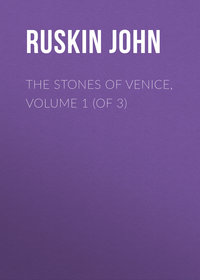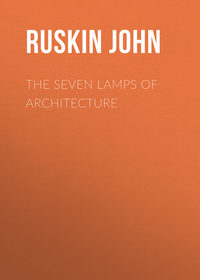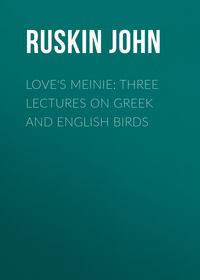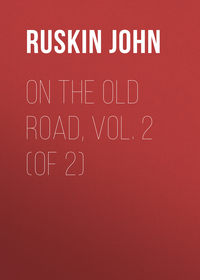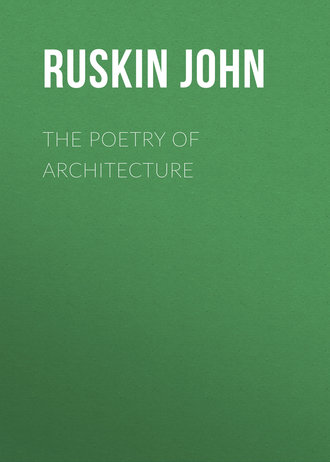 полная версия
полная версияThe Poetry of Architecture
[A reminiscence of two lines from a poem on the "Lago di Como" written by the author in 1833.]
19
Observe, we are not speaking of emotions felt on remembering what we ourselves have enjoyed, for then the imagination is productive of pleasure by replacing us in enjoyment, but of the feelings excited in the indifferent spectator, by the evident decay of power or desolation of enjoyment, of which the first ennobles, the other only harrows, the spirit.
20
In the large buildings, that is: κεραμος also signifies earthen tiling, and sometimes earthenware in general, as in Herodotus iii. 6 [where it is used of earthen jars of wine.] It appears that such tiling was frequently used in smaller edifices. The Greeks may have derived their flat roofs from Egypt. Herodotus mentions of the Labyrinth of the Twelve Kings, that ὁροφη δε παντων τουτων λιθινη, but not as if the circumstance were in the least extraordinary [Herodotus ii. 148.]
21
[Compare "The Seven Lamps of Architecture," chap. i. § 1.]
22
Shelley has caught the feeling finely:—"The house is penetrated to its corners by the peeping insolence of the day. When the time comes the crickets shall not see me."—Cenci [Act II. scene I, quoted from memory.]
23
Ugolino; Dante, Inferno xxxiii. Guido Bonatti, the astrologer of Forli, Inferno xx., 118. The lady who perished at Coll' Alto, i.e. the higher part of Colle de Val d'Elsa, between Siena and Volterra—was Sapia; Purgatorio, xiii. 100-154.
24
Length is another thing: we might divide England into strips of country, running southwest and northeast, which would be composed of the same rock, and therefore would present the same character throughout the whole of their length. Almost all our great roads cut these transversely, and therefore seldom remain for ten miles together on the same beds.
25
It is thus that we find the most perfect schools of architecture have arisen in districts whose character is unchanging. Looking to Egypt first, we find a climate inducing a perpetual state of heavy feverish excitement, fostered by great magnificence of natural phenomena, and increased by the general custom of exposing the head continually to the sun (Herodotus, bk. III. chap. 12); so that, as in a dreaming fever we imagine distorted creatures and countenances moving and living in the quiet objects of the chamber, the Egyptian endowed all existence with distorted animation; turned dogs into deities, and leeks into lightning-darters; then gradually invested the blank granite with sculptured mystery, designed in superstition, and adored in disease; and then such masses of architecture arose as, in delirium, we feel crushing down upon us with eternal weight, and see extending far into the blackness above; huge and shapeless columns of colossal life; immense and immeasurable avenues of mountain stone. This was a perfect—that is, a marked, enduring, and decided school of architecture, induced by an unchanging and peculiar character of climate. Then in the purer air, and among the more refined energies of Greece, architecture rose into a more studied beauty, equally perfect in its school, because fostered in a district not 50 miles square, and in its dependent isles and colonies, all of which were under the same air, and partook of the same features of landscape. In Rome, it became less perfect, because more imitative than indigenous, and corrupted by the traveling, and conquering, and stealing ambition of the Roman; yet still a school of architecture, because the whole of Italy presented the same peculiarities of scene. So with the Spanish and Moresco schools, and many others; passing over the Gothic, which, though we hope hereafter to show it to be no exception to the rule, involves too many complicated questions to be now brought forward as a proof of it.
[The comparison of Egyptian architecture with delirious visions seems to be an allusion to De Quincey's passage in "The Pains of Opium"—the last paper in "the Confessions of an Opium-Eater"—where, after describing Piranesi's Dreams, he tells how he fancied he was "buried for a thousand years, in stone coffins, with mummies and sphinxes, in narrow chambers at the heart of eternal pyramids," etc.]
26
Or a city. Any one who remembers entering Carlsruhe from the north by the two miles of poplar avenue, remembers entering the most soulless of all cities, by the most lifeless of all entrances.
27
As in a beautiful example in Brasenose College, Oxford.
28
The portico of the [old] Schools and the inner courts of Merton and St. John's Colleges, Oxford; an old house at Charlton, Kent; and Burleigh House, will probably occur to the mind of the architect, as good examples of the varieties of this mixed style.
29
[i.e. when the spectator is surrounded by woodland scenery. Vide ante, § 88.]
30
Namely the fact that there is no melancholy in the English play-impulse; v. ante, § 23.
31
See § 118 seq.
32
Actually carved on one of the groins of Roslin Chapel.
33
[A contributor to the "Architectural Magazine."]
34
For example, we would allow one of the modern builders of Gothic chapels a month of invention, and a botanic garden to work from, with perfect certainty that he would not, at the expiration of the time, be able to present us with one design of leafage equal in beauty to hundreds we could point out in the capitals and niches of Melrose and Roslin.
35
[Though not in this order. C is the intellectual window; B, the imaginative one.]
36
It is too much the custom to consider a design as composed of a certain number of hard lines, instead of a certain number of shadows of various depth and dimension. Though these shadows change their position in the course of the day, they are relatively always the same. They have most variety under a strong light without sun, most expression with the sun. A little observation of the infinite variety of shade which the sun is capable of casting, as it touches projections of different curve and character, will enable the designer to be certain of his effects. We shall have occasion to allude to this subject again. [See Seven Lamps of Architecture, III. 13, 23.]
37
The nation, indeed, possesses one or two interesting individuals, whose affectation is, as we have seen, strikingly manifested in their lake villas: but every rule has its exceptions; and, even on these gifted personages, the affectation sits so very awkwardly, so like a velvet bonnet on a plowman's carroty hair, that it is evidently a late acquisition. Thus, one proprietor of land on Windermere, who has built unto himself a castellated mansion with round towers, and a Swiss cottage for a stable, has yet, with that admiration of the "neat but not gaudy," which is commonly reported to have influenced the devil when he painted his tail pea-green, painted the rocks at the back of his house pink, that they may look clean. This is a little outcrop of English feeling in the midst of the assumed romance.
38
In leaving simple blue country, we hope it need hardly be said that we leave bricks at once and forever. Nothing can excuse them out of their proper territory.
39
The epithet "raw," by the by, is vague, and needs definition. Every tint is raw which is perfectly opaque, and has not all the three primitive colors in its composition. Thus, black is always raw, because it has no color; white never, because it has all colors. No tint can be raw which is not opaque; and opacity may be taken away, either by actual depth and transparency, as in the sky; by luster and texture, as in the case of silk and velvet, or by variety of shade as in forest verdure. Two instances will be sufficient to prove the truth of this. Brick, when first fired, is always raw; but when it has been a little weathered, it acquires a slight blue tint, assisted by the gray of the mortar: incipient vegetation affords it the yellow. It thus obtains an admixture of the three colors, and is raw no longer. An old woman's red cloak, though glaring, is never raw; for it must of necessity have folded shades: those shades are of a rich gray; no gray can exist without yellow and blue. We have then three colors, and no rawness. It must be observed however, that when any one of the colors is given in so slight a degree that it can be overpowered by certain effects of light, the united color, when opaque, will be raw. Thus many flesh-colors are raw; because, though they must have a little blue in their composition, it is too little to be efficiently visible in a strong light.
40
There must always be a difficulty in building in picturesque blue country in England; for the English character is opposed to that of the country: it is neither graceful, nor mysterious, nor voluptuous; therefore, what we cede to the country, we take from the nationality, and vice versâ.
41
[See Stones of Venice, vol. III. chap. iii.]
42
Every one who is about to lay out a limited extent of garden, in which he wishes to introduce many flowers, should read and attentively study, first Shelley, and next Shakspeare. The latter indeed induces the most beautiful connections between thought and flower that can be found in the whole range of European literature; but he very often uses the symbolical effect of the flower, which it can only have on the educated mind, instead of the natural and true effect of the flower, which it must have, more or less, upon every mind. Thus, when Ophelia, presenting her wild flowers, says, "There's rosemary, that's for remembrance; pray you, love, remember: and there is pansies, that's for thoughts:" the infinite "beauty of the passage depends entirely upon the arbitrary meaning attached to the flowers. But, when Shelley speaks of
"The lily of the vale,Whom youth makes so fair, and passion so pale,That the light of her tremulous bells is seenThrough their pavilion of tender green,"he is etherealizing an impression which the mind naturally receives from the flower. Consequently, as it is only by their natural influence that flowers can address the mind through the eye, we must read Shelley, to learn how to use flowers, and Shakspeare, to learn to love them. In both writers we find the wild flower possessing soul as well as life, and mingling its influence most intimately, like an untaught melody, with the deepest and most secret streams of human emotion.
43
[Compare Modern Painters. vol. III. chap. x. § 15.]
44
[This passage seems to suggest that the Villa Pliniana on Como was built by Pliny. It was, however, the work of an antiquarian nobleman of the Renaissance, and merely named after the great naturalist, who was born, perhaps, at Como, and mentions an ebbing spring on this site.]
45
For instance, one proprietor terrifies the landscape all round him, within a range of three miles, by the conspicuous position of his habitation; and is punished by finding that, from whatever quarter the wind may blow, it sends in some of his plate-glass. Another spoils a pretty bit of crag by building below it, and has two or three tons of stone dropped through his roof, the first frosty night. Another occupies the turfy slope of some soft lake promontory, and has his cook washed away by the first flood. We do not remember ever having seen a dwelling-house destroying the effect of a landscape, of which, considered merely as a habitation, we should wish to be the possessor.
46
We are not thinking of the effect upon the human frame of the air which is favorable to vegetation. Chemically considered, the bracing breeze of the more sterile soil is the most conducive to health, and is practically so, when the frame is not perpetually exposed to it; but the keenness which checks the growth of the plant is, in all probability, trying, to say the least, to the constitution of a resident.
47
We hope the English language may long retain this corrupt but energetic superlative.
48
This position, as well as the two preceding, is important, and in need of confirmation. It has often been observed, that, when the eye is altogether unpracticed in estimating elevation, it believes every point to be lower than it really is; but this does not militate against the proposition, for it is also well known, that the higher the point, the greater the deception. But when the eye is thoroughly practiced in mountain measurement, although the judgment, arguing from technical knowledge, gives a true result, the impression on the feelings is always at variance with it, except in hills of the middle height. We are perpetually astonished, in our own country, by the sublime impression left by such hills as Skiddaw, or Cader Idris, or Ben Venue; perpetually vexed, in Switzerland, by finding that, setting aside circumstances of form and color, the abstract impression of elevation is (except in some moments of peculiar effect, worth a king's ransom) inferior to the truth. We were standing the other day on the slope of the Brevent, above the Prieuré of Chamouni, with a companion, well practiced in climbing Highland hills, but a stranger among the Alps. Pointing out a rock above the Glacier des Bossons, we requested an opinion of its height. "I should think," was the reply, "I could climb it in two steps; but I am too well used to hills to be taken in in that way; it is at least 40 feet." The real height was 470 feet. This deception is attributable to several causes (independently of the clearness of the medium through which the object is seen), which it would be out of place to discuss here, but the chief of which is the natural tendency of the feelings always to believe objects subtending the same angle to be of the same height. We say the feelings, not the eye; for the practiced eye never betrays its possessor, though the due and corresponding mental impression is not received.
49
This is rather a bold assertion; and we should be sorry to maintain the fact as universal; but the crystals of almost all the rarer minerals are larger in the larger mountain; and that altogether independently of the period of elevation, which, in the case of Mont Blanc, is later than that of our own Mendips.
50
In § 166 we noticed the kind of error most common in amateur designs, and we traced that error to its great first cause, the assumption of the humor, instead of the true character, for a guide; but we did not sufficiently specify the mode in which that first cause operated, by prompting to imitation. By imitation we do not mean accurate copying, neither do we mean working under the influence of the feelings by which we may suppose the originators of a given model to have been actuated; but we mean the intermediate step of endeavoring to combine old materials in a novel manner. True copying may be disdained by architects, but it should not be disdained by nations; for when the feelings of the time in which certain styles had their origin have passed away, any examples of the same style will invariably be failures, unless they be copies. It is utter absurdity to talk of building Greek edifices now; no man ever will, or ever can, who does not believe in the Greek mythology; and, precisely by so much as he diverges from the technicality of strict copyism, he will err. But we ought to have pieces of Greek architecture, as we have reprints of the most valuable records, and it is better to build a new Parthenon than to set up the old one. Let the dust and the desolation of the Acropolis be undisturbed forever; let them be left to be the school of our moral feelings, not of our mechanical perceptions; the line and rule of the prying carpenter should not come into the quiet and holy places of the earth. Elsewhere, we may build marble models for the education of the national mind and eye; but it is useless to think of adapting the architecture of the Greek to the purposes of the Frank; it never has been done, and never will be. We delight, indeed, in observing the rise of such a building as La Madeleine: beautiful, because accurately copied; useful, as teaching the eye of every passer-by. But we must not think of its purpose; it is wholly unadapted for Christian worship; and were it as bad Greek as our National Gallery, it would be equally unfit.
The mistake of our architects in general is, that they fancy they are speaking good English by speaking bad Greek. We wish, therefore, that copying were more in vogue than it is. But imitation, the endeavor to be Gothic, or Tyrolese, or Venetian, without the slightest grain of Gothic or Venetian feeling; the futile effort to splash a building into age, or daub it into dignity, to zigzag it into sanctity, or slit it into ferocity, when its shell is neither ancient nor dignified, and its spirit neither priestly nor baronial,—this is the degrading vice of the age; fostered, as if man's reason were but a step between the brains of a kitten and a monkey, in the mixed love of despicable excitement and miserable mimicry.
If the English have no imagination, they should not scorn to be commonplace; or rather they should remember that poverty cannot be disguised by beggarly borrowing, that it may be ennobled by calm independence. Our national architecture never will improve until our population are generally convinced that in this art, as in all others, they cannot seem what they cannot be. The scarlet coat or the turned-down collar, which the obsequious portrait-painter puts on the shoulders and off the necks of his savage or insane customers, never can make the 'prentice look military, or the idiot poetical; and the architectural appurtenances of Norman embrasure or Veronaic balcony must be equally ineffective, until they can turn shopkeepers into barons, and schoolgirls into Juliets. Let the national mind be elevated in its character, and it will naturally become pure in its conceptions; let it be simple in its desires, and it will be beautiful in its ideas; let it be modest in feeling, and it will not be insolent in stone. For architect and for employer, there can be but one rule; to be natural in all that they do, and to look for the beauty of the material creation as they would for that of the human form, not in the chanceful and changing disposition of artificial decoration, but in the manifestation of the pure and animating spirit which keeps it from the coldness of the grave. [With this remarkable foreshadowing of Mr. Ruskin's Art-teaching compare Seven Lamps and Lectures on Architecture and Painting, throughout.]
51
[Referring again to the intended sequel.]
52
This difference of principle is one leading distinction between the artist, properly so called, and the scene, diorama, or panorama painter.
53
[For further discussion of which, see Elements of Drawing, Letter III.]
54
[In their turrets and pinnacles, as shown by a poor wood-cut in the magazine, not worth reproduction.]
55
[Compare Modern Painters, vol. IV. chap. xvii. § 49, and Elements of Drawing, Letter III.]




